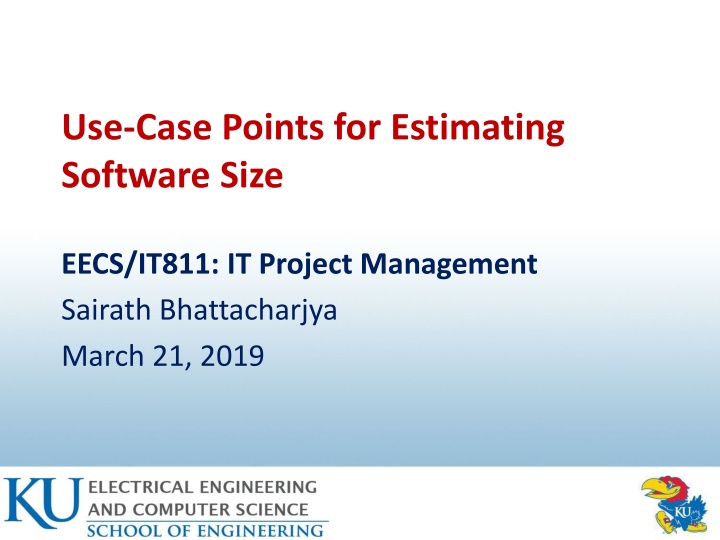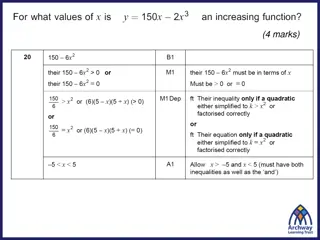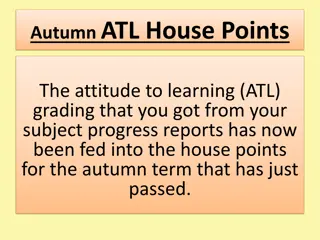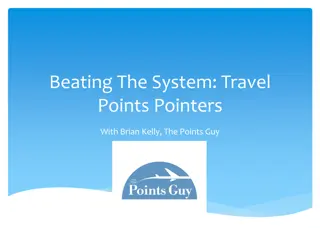
Efficient Software Size Estimation Using Use Case Points
"Explore the methodology of estimating software size with Use-Case Points (UCP) for efficient IT project management. Discover the principles, calculation methods, and advantages of UCP, leading towards agile development practices."
Download Presentation

Please find below an Image/Link to download the presentation.
The content on the website is provided AS IS for your information and personal use only. It may not be sold, licensed, or shared on other websites without obtaining consent from the author. If you encounter any issues during the download, it is possible that the publisher has removed the file from their server.
You are allowed to download the files provided on this website for personal or commercial use, subject to the condition that they are used lawfully. All files are the property of their respective owners.
The content on the website is provided AS IS for your information and personal use only. It may not be sold, licensed, or shared on other websites without obtaining consent from the author.
E N D
Presentation Transcript
Use-Case Points for Estimating Software Size EECS/IT811: IT Project Management Sairath Bhattacharjya March 21, 2019
Organization Introduction What is use case? Use case 2.0 Basic principle of application of use case Software effort estimation Use case points calculation Usage of UCP The agile way Conclusions Question & Answer 2
Resources Used All resources shared by Professor Saiedian (on class website) Book chapters White papers Articles Wikipedia 3
Why I chose the use-case point topic? Use case is a very popular method for requirement gathering Ties the triple constrains (scope, time and cost) really well Considers non-functional and environmental factors for software development A more scientific method for estimation Leads towards agile development 4
What is a use case? [1 of 4] A use case is all the ways of using a system to achieve a particular goal for a particular user. Taken together the set of all the use cases gives you all of the useful ways to use the system, and illustrates the value that it will provide. Source: https://www.ivarjacobson.com/sites/default/files/field_iji_file/article/use-case_2_0_jan11.pdf 5
What is a use case? [2 of 4] A popular approach of collecting the requirements A user-centric approach: a specific situation in which a product or service could potentially be used by a user Can be developed to tell a story of how the system will be used from the perspective of each actor 6
Use case 2.0 [1 of 2] A scalable, agile practice that uses use cases to capture a set of requirements Drive the incremental development of a system Features of use case 2.0: Lightweight Scalable Versatile Easy to use 9
Basic principle of application of use case Keep it simple by telling stories Understand the big picture Focus on value Build the system in slices Deliver the system in increments Adapt to meet the team s needs 11
Software effort estimation Objective: estimate the most realistic amount of efforts to complete a project There are many methods Expert judgment Analogy-based estimation Size-based models Function points Feature points Use case points Story points 12
Use case points [1 of 2] Use Case Points (UCP) is a software estimation technique used to forecast the software size for software development projects Helps in determining the overall completion date of a project Helps in release planning 13
Use case points [2 of 2] The number of use case points in a project is a function of the following: The number and complexity of the use cases in the system (UUCW) The number and complexity of the actors on the system (UAW) various non-functional requirements (TCF) the environment in which the project will be developed (EF) 14
Unadjusted Use Case Weight (UUCW) [1 of 3] Shows the main scenario and extensions 2a, 2b, 2c and 3a are outcomes and not considered a transaction Total transactions: 10 15
Unadjusted Use Case Weight (UUCW) [1 of 3] Based on the number of transactions the complexity is defined as follows: 16
Unadjusted Use Case Weight (UUCW) [3 of 3] Each use case is categorized based on transactions Each complexity is assigned a weight The summation of product of weight and number of use case gives the UUCW In our example UUCW = 260 17
Unadjusted Actor Weight (UAW) [1 of 2] An actor can be a person, system or program Complexity is defined based on the type of actor 18
Unadjusted Actor Weight (UAW) [2 of 2] Each use case is assigned a weight based on the complexity of the actors interacting with the system The summation of product of weight and number of use case gives the UAW In our example UAW = 140 19
Technical Complexity (TCF) [3 of 3] There are 13 standard technical factors to estimate the impact on productivity Weight is the relative impact Assessment is the perceived complexity of each factor The summation of the product of weight and assessment gives the Tfactor TFC is calculated as TCF = 0.6 + (0.01 * TFactor) In our example TCF = 0.6 + (0.01 * 42) = 1.02 22
Environmental Complexity (EF) [1 of 3] More experienced teams will have a greater impact on the UCP Development team assigns perceived complexity for each factor between 1 and 5 The EFactor is calculated as a sum of the product of weight and assessment. The EF is calculated as EF = 1.4 + ( 0.03 EFactor) In our case EF = 1.4 + ( 0.03 17.5) = 1.4 + ( 0.51) = 0.89 25
Calculating the UCP Use Case Point (UCP) is calculate as UCP = (UUCW + UAW) TCF EF In our example, UCP = (260 + 140) 1.02 0.89 = 363 26
Effort estimation Use Case Points (UCP) = 363 Considering 20 hours per UCP Total hours for project: 363 * 20 = 7,260 hours Considering iterations are of 2 weeks 5 people are working in the project (40 hours/week) Total iterations: 7260 / (5 * 40 * 2) = ~ 19 Total time for completion: 38 weeks 27
Cost estimation Total hours for project: 7,260 hours Rate per person: $45/hour Total cost of the project = 45 * 7260 = $326,700 Considering additional costs and buffers the project should cost around $350,000 28
Release planning Weight of use case per iteration: Unadjusted Use Case Weight (UUCW) by the number of iterations gives the Weight per iteration = UUCW / iterations In our case: 260 / 19 = 13.7 (~14) Defines the expected velocity of the team Actual velocity is compared against this to determine if the project is in schedule 29
The agile way Use case can be considered as a Epic Scenarios in a use case can be considered as a user story Completion of all the scenarios results in completion of the use case Ties back to use case 2.0 objectives 30
Conclusions UCP helps in resource planning Helps in providing a early estimate of the effort required UCP method is versatile and extensible to a variety of development and testing projects. 31
Resources used [1 of 6] All resources shared by Professor Saiedian (on class website) Book: Use case points Chapter 6 Wikipedia Use case Wikipedia - Software development effort estimation 33
Resources used [2 of 6] Title: Use Case 2.0, the guide to succeeding with use case Author: Dr. Ivar Jacobson, Ian Spence, Kurt Bittner Edition: December 2011 Type: EBook Link: https://www.ivarjacobson.com/sites/default/fil es/field_iji_file/article/use-case_2_0_jan11.pdf 34
Resources used [3 of 6] Title: Introduction to use case Author: Ian Gibson, Matthew Hause (Artisan Software) Type: Presentation Link: https://incoseonline.org.uk/Documents/Bristo l/BLG070328-Use-Case.pdf 35
Resources used [4 of 6] Title: Getting Started With Use Case Modeling Author: Jan Kettenis, Oracle Corporation Edition: May 2007 Type: White paper Link: https://www.oracle.com/technetwork/testcont ent/gettingstartedwithusecasemodeling- 133857.pdf 36
Resources used [5 of 6] Title: Project Estimation With Use Case Points Author: Roy K. Clemmons Edition: February 2006 Type: Article Journal: CROSSTALK The Journal of Defense Software Engineering Link: http://www.royclemmons.com/articles/docs/0602 Clemmons.pdf 37
Resources used [6 of 6] Title: Estimating Effort by Use Case Points: Method, Tool and Case Study Author: S. Kusumoto, F. Matukawa, K. Inoue, S. Hanabusa, Y. Maegawa Edition: September 2004 Type: Article Journal: 10th International Symposium on Software Metrics, 2004. Proceedings. Link: https://ieeexplore.ieee.org/document/1357913 http://citeseerx.ist.psu.edu/viewdoc/download?doi=10. 1.1.474.9332&rep=rep1&type=pdf 38














